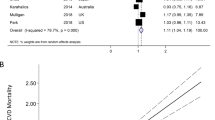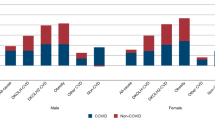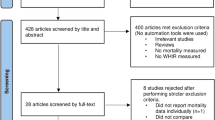Abstract
Background:
A recent analysis concluded that there were fewer excess deaths attributable to obesity in the US population than previously believed. This analysis may not have fully corrected for two putative biases, the regression-dilution and the reverse-causation biases. It is not presently known whether correcting for these biases would increase estimates of excess deaths attributable to obesity.
Methods:
All-cause mortality hazard ratios (HRs) for different body mass index (BMI) categories were calculated and adjusted for confounding factors, using data from the prospective Atherosclerosis Risk in Communities Study. The analysis was based on 12 457 individuals aged 51–70 years and 606 all-cause deaths during a 5.3-year follow-up. The HRs were corrected for the regression-dilution and reverse-causation biases, and compared with data from a previously published study to evaluate the effects of correcting for these putative biases on estimates of excess deaths attributable to obesity in the US population.
Results:
The uncorrected all-cause mortality HR for obesity (BMI⩾30) was 1.26 (95% confidence interval (95% CI)=1.01–1.58), using the 21–25 kg/m2 as ideal-weight category. Correcting for regression dilution increased the HR to 1.46 (95% CI=1.17–1.83). Correcting for both putative biases increased it further to 2.70 (95% CI=1.31–5.57). Such increases in HRs are consonant with increases of several hundred percent in estimates of deaths attributable to obesity in the US.
Conclusions:
Correcting for putative biases yielded increases in all-cause mortality HRs for obesity that correspond to substantial increases in estimates of excess deaths attributable to obesity in the US population.
This is a preview of subscription content, access via your institution
Access options
Subscribe to this journal
Receive 12 print issues and online access
$259.00 per year
only $21.58 per issue
Buy this article
- Purchase on Springer Link
- Instant access to full article PDF
Prices may be subject to local taxes which are calculated during checkout


Similar content being viewed by others
References
Flegal KM, Graubard BI, Williamson DF, Gail MH . Excess deaths associated with underweight, overweight and obesity. JAMA 2005; 293: 1861–1867.
Allison DB, Fontaine KR, Manson JE, Stevens J, VanItallie TB . Annual deaths attributable to obesity in the United States. JAMA 1999; 282: 1530–1538.
Mokdad AH, Marks JS, Stroup DF, Geberding JL . Actual causes of death in the United States, 2000. JAMA 2004; 291: 1238–1245.
Mokdad AH, Marks JS, Stroup DF, Gerberding JL . Correction: actual causes of death in the United States, 2000. JAMA 2005; 293: 293–294 & 298.
Manson JE, Stampfer MJ, Hennekens CH, Willett WC . Body weight and longevity: a reassessment. JAMA 1987; 257: 353–358.
Clarke R, Shipley M, Lewington S, Youngman L, Collins R, Marmot M et al. Underestimation of risk associations due to regression dilution in long-term follow-up prospective studies. Am J Epidemiol 1999; 150: 341–353.
The ARIC Investigators. The Atherosclerosis Risk in Communities (ARIC) Study: design and objectives. Am J Epidemiol 1989; 129: 687–702.
Jackson R, Chambless L, Yang K, Byrne T, Watson R, Folsom A et al. Differences between respondents and non-respondents in a multi-center community-based study vary by gender and ethnicity. J Clin Epidemiol 1996; 49: 1441–1446.
Cox DR . Regression models and life tables. J Roy Stat Soc SerB 1971–1975; 34: 187–220.
Kleinbaum DG . Survival Analysis. Springer-Verlag: New York, 1996. Chapter 4, pp 129–170.
Clinical Guidelines on the Identification Evaluation and Treatment of overweight and obesity in Adults – the Evidence Report. National Institutes of Health. Obes Res 1998; 6: 51S–209S.
Hughes MD . Regression dilution in the proportional hazards model. Biometrics 5b 1993; 49: 1056–1065.
Spearman C . The proof and measurement of association between two things. Am J Psychol 1904; 15: 72–101.
MacMahon S, Peto R, Cutler J, Collins R, Sorlie P, Neaton J et al. Blood pressure, stroke, and coronary heart disease. Part 1, Prolonged differences in blood pressure: prospective observational studies corrected for the regression dilution bias. Lancet 1990; 335: 765–774.
Knuiman MW, Divitini ML, Buzas JS, Fitzgerald PE . Adjustments for regression dilution in epidemiological regression analysis. Ann Epidemiol 1998; 8: 56–63.
Emberson JR, Shaper AG, Wannamethee SG, Morris RW, Whincup PH . Alcohol intake in middle age and risk of cardiovascular disease and mortality: accounting for intake variation over time. Am J Epidemiol 2005; 161: 856–863.
Wu T, Willett WC, Hankinson SE, Giovannucci E . Caffeinated coffee, decaffeinated coffee, and caffeine in relation to plasma C-peptide levels, a marker of insulin section, in US women. Diabetes Care 2005; 28: 1390–1396.
Hu FB, Willett WC, Li T, Stampfer MJ, Colditz GA, Manson JE . Adiposity as compared with physical activity in predicting mortality among women. NEJM 2004; 351: 2694–2703.
Greenberg JA . Removing confounders from the relationship between mortality risk and systolic blood pressure at low and moderately increased systolic blood pressure. J Hypertens 2003; 21: 49–56.
Emberson JR, Whincup PH, Morris RW, Walker M, Lowe GDO, Rumley A . Extent of regression dilution for established and novel coronary risk factors: results from the British Regional Heart Study. Eur J Cardiovasc Prevention Rehab 2004; 11: 125–134.
Carroll RJ, Ruppert D, Stefanski LA . Measurement Error in Nonlinear Models. Chapman & Hall: New York, 1995. p 8.
Vartiainen E, Seppala T, Lillsunde P, Puska P . Validation of self reported smoking by serum cotinine measurement in a community-based study. J Epidemiol Community Health 2002; 56: 167–170.
Haapanen N, Miilunpalo S, Pasanen M, Oja P, Vuori I . Agreement between questionnaire data and medical records of chronic diseases in middle-aged and elderly Finnish men and women. Am J Epidemiol 1997; 145: 762–769.
Frost C, Thompson SG . Correcting for regression dilution bias: comparison of methods for a single predictor variable. J R Statist Soc A 2000; 163: 173–189.
Acknowledgements
The Atherosclerosis Risk in Communities Study (ARIC) is conducted and supported by the National Heart Lung and Blood Institute (NHLBI) in collaboration with the ARIC investigators. This manuscript was prepared using a limited access dataset obtained by the NHLBI and does not necessarily reflect the opinions or views of the ARIC or the NHLBI. This work is supported in part by NIH grant P30DK056336.
Author information
Authors and Affiliations
Corresponding author
Rights and permissions
About this article
Cite this article
Greenberg, J., Fontaine, K. & Allison, D. Putative biases in estimating mortality attributable to obesity in the US population. Int J Obes 31, 1449–1455 (2007). https://doi.org/10.1038/sj.ijo.0803615
Received:
Revised:
Accepted:
Published:
Issue Date:
DOI: https://doi.org/10.1038/sj.ijo.0803615
Keywords
This article is cited by
-
The dynamic association of body mass index and all-cause mortality in multiple cohorts and its impacts
Emerging Themes in Epidemiology (2014)
-
Biased Corrections or Biased About Corrections?
Obesity (2009)
-
Reply to Flegal et al.
International Journal of Obesity (2008)
-
BMI and mortality: sorting through the data to find the public health message
International Journal of Obesity (2008)
-
Simple examples should not be extrapolated to the US population
International Journal of Obesity (2008)



